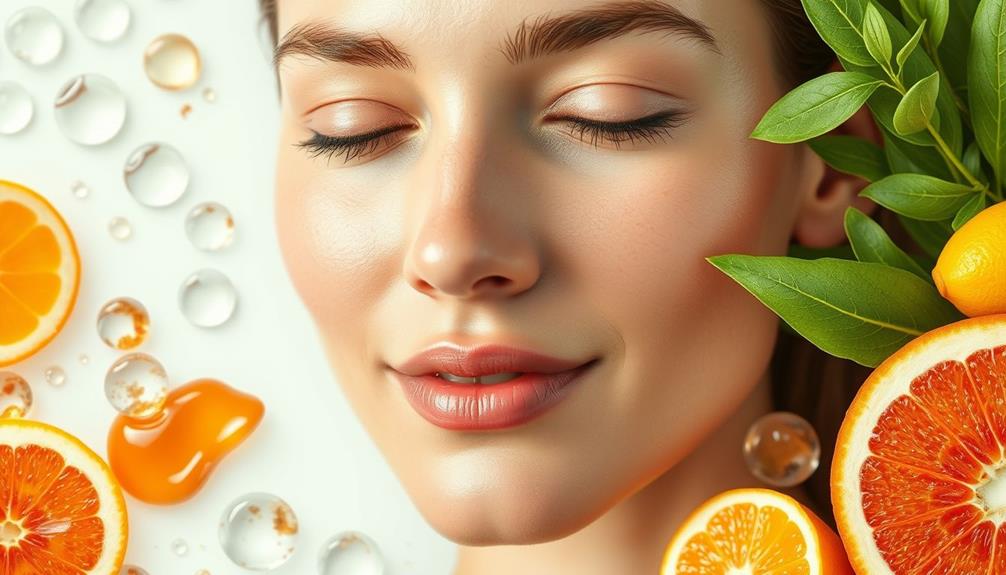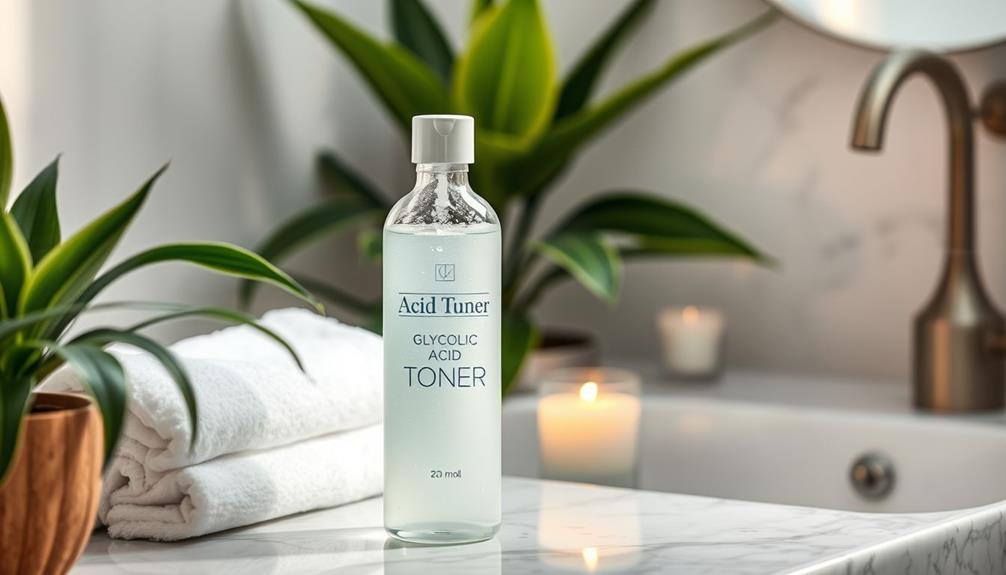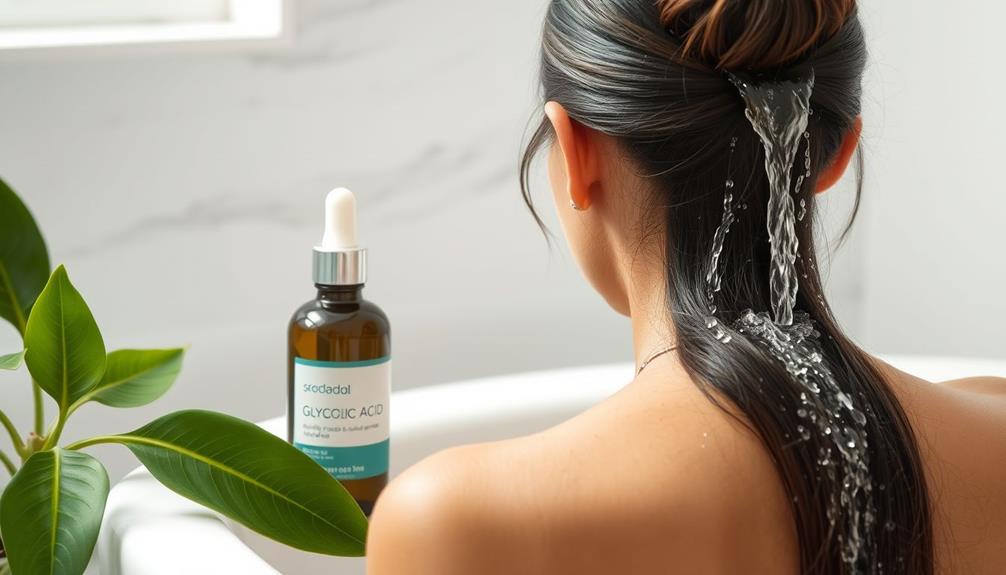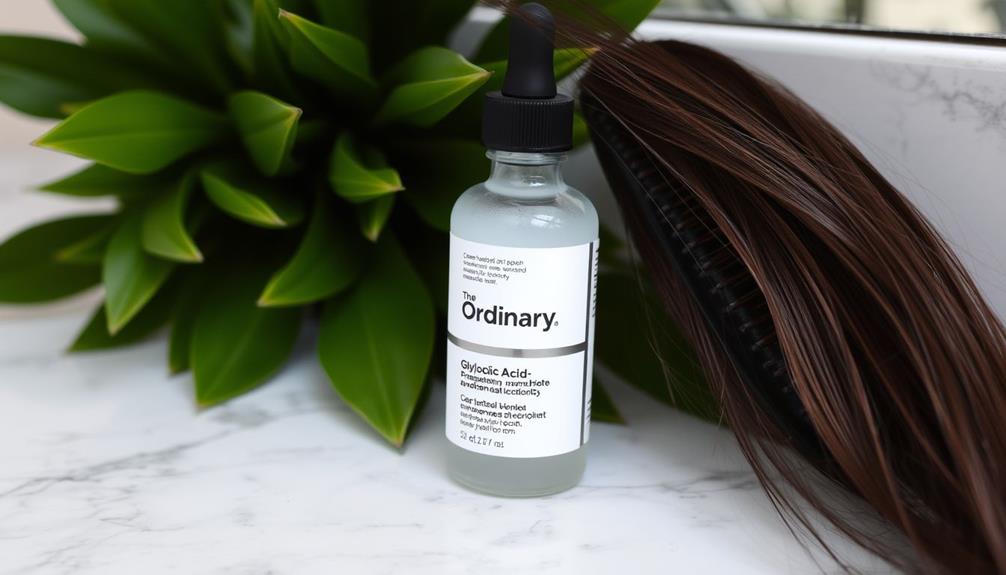Glycolic acid is a potent skincare ingredient that can significantly enhance your skin. It functions by gently exfoliating dead skin cells, unveiling a more radiant and smoother complexion while improving texture and tone. You will see a decrease in fine lines, dark spots, and acne as it unclogs pores and promotes collagen production. However, it is essential to begin with lower concentrations and observe how your skin reacts to prevent irritation. Daily sunscreen is crucial because glycolic acid heightens UV sensitivity. Learn how to safely add this ingredient to your routine and optimize its advantages for your skin.
Key Takeaways
- Glycolic acid, an alpha-hydroxy acid from sugar cane, promotes skin cell turnover for a brighter and smoother complexion.
- It effectively treats acne by unclogging pores and reducing breakouts through enhanced exfoliation.
- Regular use stimulates collagen production, improving skin elasticity and reducing the appearance of fine lines and wrinkles.
- Starting with lower concentrations and gradually increasing usage helps minimize irritation and maximize benefits.
Overview of Glycolic Acid
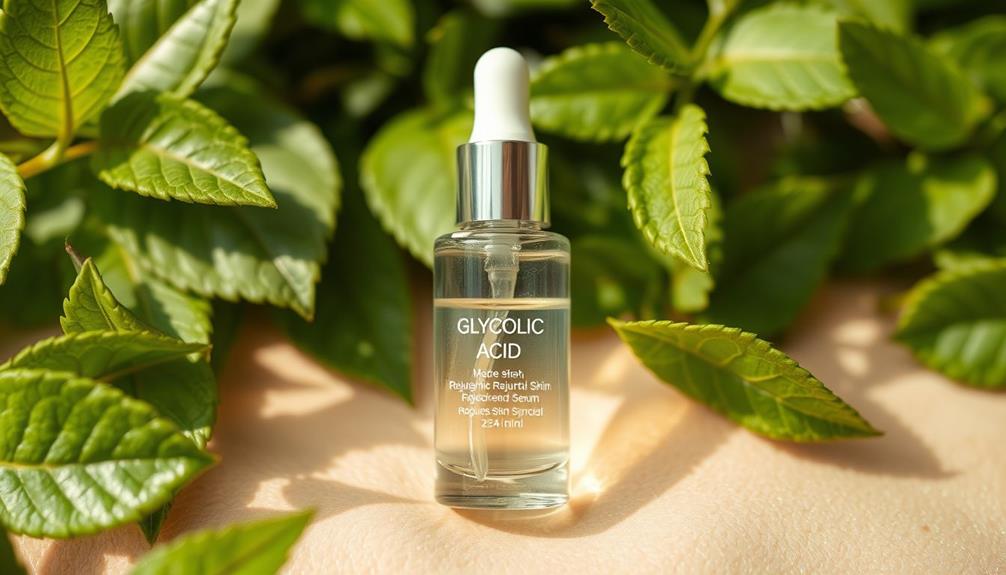
Glycolic acid, a powerful alpha-hydroxy acid derived from sugar cane, works wonders for your skin by effectively exfoliating and improving texture and tone. Its exfoliating properties are unmatched, thanks to its small molecular size, which allows for deeper skin penetration compared to other AHAs.
When you use glycolic acid, you're promoting increased cell turnover, breaking down the bonds between dead skin cells, and revealing a brighter, smoother complexion.
Additionally, incorporating essential oils into your skincare routine can enhance its benefits, as they provide additional healing properties and promote relaxation during application.
Regular application can considerably enhance your skin texture, making it a popular choice for treating fine lines and hyperpigmentation.
By stimulating collagen production, glycolic acid helps firm your skin, reducing the appearance of wrinkles over time.
It's also an effective acne treatment, unclogging pores and preventing breakouts.
Using products with concentrations ranging from 5% to 10% can yield impressive results.
Whether you're battling the signs of aging or looking to improve your overall skin health, glycolic acid can be an essential part of your skincare routine.
Just remember to start slow to gauge your skin's response, and always follow up with sunscreen during the day, as AHAs can increase your skin's sensitivity to the sun.
Mechanism of Action

When you apply glycolic acid, it starts by exfoliating the outer layer of dead skin cells, revealing a fresher complexion.
This process not only accelerates cell turnover but also stimulates collagen production, improving your skin's firmness and elasticity.
Additionally, incorporating essential oils for skin health can enhance your skincare routine.
As you continue using it, you'll notice brighter skin and fewer clogged pores, which can help reduce acne breakouts.
Exfoliation Process Explained
Exfoliation happens as glycolic acid loosens the bonds between dead skin cells, making it easier for them to be removed from your skin's surface. This process is essential for maintaining a clear and radiant complexion.
Glycolic acid, a type of alpha hydroxy acid, penetrates deeply into the skin due to its small molecular size, enhancing exfoliation efficiency. Incorporating gentle yoga stretches before bedtime can also improve overall skin health by promoting better circulation, which is critical for nutrient delivery to skin cells. Additionally, maintaining a consistent sleep schedule can enhance your skin's natural repair processes, leading to a more vibrant appearance yoga for better skin.
As you use glycolic acid, you'll notice an increase in cell turnover, which brings fresher, healthier skin layers to the top. This accelerated turnover not only helps reduce the buildup of dead skin cells but also works to unclog pores, greatly lowering the chances of acne breakouts.
Furthermore, the exfoliation process boosts collagen production, which plays an important role in improving skin elasticity and overall skin texture. With regular use, you can expect a smoother surface and more youthful-looking skin.
Incorporating glycolic acid into your skincare routine can lead to noticeable improvements, making your skin feel rejuvenated and vibrant. So, if you're ready to enhance your skincare regimen, glycolic acid is a powerful ally in achieving that goal.
Collagen Stimulation Effects
By promoting skin cell turnover, glycolic acid effectively stimulates collagen production, leading to firmer and more youthful-looking skin. This powerful ingredient penetrates deeply into the dermal layer, acting directly on fibroblasts—the cells responsible for generating collagen. As a result, you'll notice an improvement in skin texture, elasticity, and a reduction in fine lines and wrinkles.
Research supports these claims, with clinical trials showing that consistent use of glycolic acid can greatly boost collagen levels, enhancing your skin's overall quality. Here's a quick overview of how glycolic acid affects your skin:
| Effect | Outcome |
|---|---|
| Collagen Production | Increased firmness and elasticity |
| Skin Texture Improvement | Smoother appearance |
| Reduction in Fine Lines & Wrinkles | Youthful look |
With regular application, you can expect noticeable changes within weeks, achieving that coveted youthful glow. Embracing glycolic acid in your skincare routine could be your key to revitalizing your skin and maintaining its health for years to come.
Cell Turnover Acceleration
Glycolic acid speeds up cell turnover by breaking down the bonds that keep dead skin cells attached, allowing for a fresher, more radiant complexion.
As it promotes the shedding of the outer layer of skin, you'll notice an improvement in your skin texture and tone. This acceleration in cell turnover brings new skin cells to the surface more quickly, enhancing your natural exfoliation process.
Additionally, the holistic approaches in therapies, similar to those found in self-exploration through body awareness, can also support overall skin health and emotional well-being.
Regular use of glycolic acid can greatly boost collagen production, which thickens the skin and improves its elasticity. This means not only a more vibrant appearance but also a more youthful one.
The small molecular size of glycolic acid allows for deeper penetration compared to other alpha-hydroxy acids, making it particularly effective in promoting cell turnover.
Benefits for Skin Health

Harnessing the power of glycolic acid can transform your skin health, delivering a brighter, smoother complexion and reducing the appearance of fine lines. This incredible ingredient offers multiple benefits that can enhance your skincare routine considerably.
Additionally, just as understanding a cat's body language is key to interpreting its needs, recognizing how your skin reacts to various ingredients is essential for ideal results.
- Exfoliation: Glycolic acid accelerates cell turnover, removing dead skin cells and revealing fresh, radiant skin.
- Collagen Production: It stimulates collagen production, helping to firm your skin and improve elasticity, which reduces fine lines and wrinkles.
- Fade Dark Spots: Regular use can effectively fade dark spots and hyperpigmentation, including those caused by acne and sun damage.
- Acne Treatment: Glycolic acid is excellent for treating mild to moderate acne, as it unclogs pores and minimizes breakouts.
Integrating glycolic acid into your skincare routine not only revitalizes your complexion but also targets specific skin concerns, making it a versatile ally for achieving ideal skin health.
With consistent use, you'll enjoy the numerous benefits glycolic acid brings, paving the way for a healthier, more youthful appearance.
Safe Application Guidelines
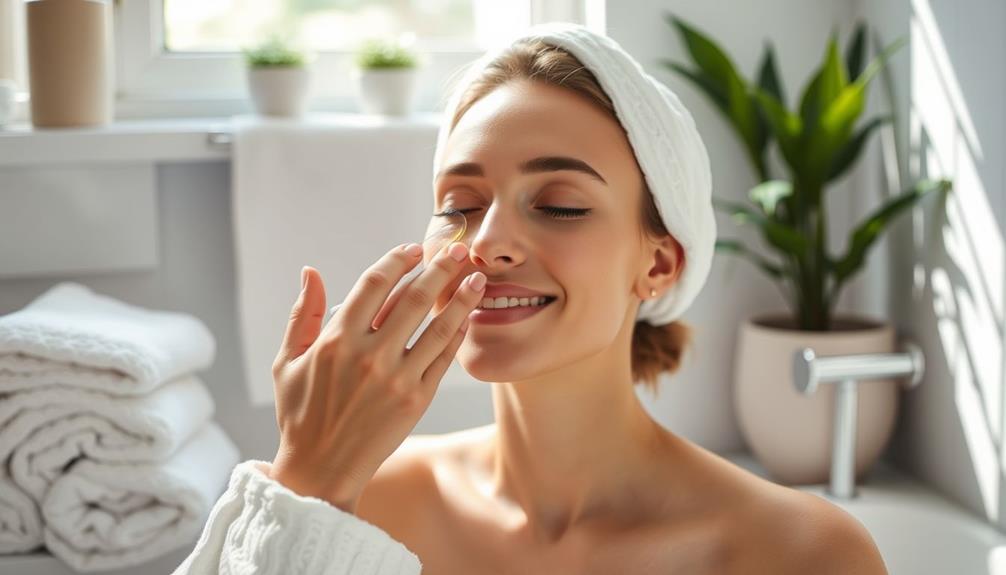
When using glycolic acid, start with a lower concentration and gradually increase your usage to see how your skin reacts.
It's important to remember that wisdom-infused quotes from literature can provide inspiration for self-care and beauty routines.
Additionally, it's essential to apply it in the evening and always protect your skin with a broad-spectrum sunscreen during the day.
Following these guidelines will help you enjoy the benefits while minimizing potential risks.
Gradual Usage Recommendations
To effectively incorporate glycolic acid into your skincare routine, start with a low concentration and gradually increase it based on how your skin reacts.
Begin using products with lower concentrations, around 5%, to assess skin tolerance. Consider these gradual usage recommendations to minimize any potential skin irritation: Regular skin assessment is essential for maintaining overall health, much like how regular vet check-ups are important for ensuring a cat's well-being.
- Apply glycolic acid three times a week in the evening to reduce the risk of photosensitivity.
- Monitor your skin's response closely, and if you notice excessive irritation, cut back on usage.
- Once your skin adjusts, you can increase the concentration to 10% or more as needed.
- Always perform patch testing on a small area of skin before widespread use to check for any adverse reactions.
Importance of Sun Protection
Applying glycolic acid can greatly enhance your skin's appearance, but it also heightens sensitivity to UV rays, making sun protection vital.
To protect your skin, you should incorporate daily sunscreen into your skincare routine. Opt for a broad-spectrum sunscreen with at least SPF 30, applying it every day, even on cloudy days. This practice is essential to combat the photosensitivity caused by glycolic acid.
When you're outdoors, don't forget to reapply sunscreen every two hours, especially after sweating or swimming. This guarantees ideal protection against sunburn and long-term damage, such as hyperpigmentation and premature aging.
As you gradually introduce glycolic acid into your regimen, remember that diligent sun protection complements its benefits. It not only helps maintain your skin's health but also minimizes adverse reactions related to sun exposure.
Limitations for Scar Treatment
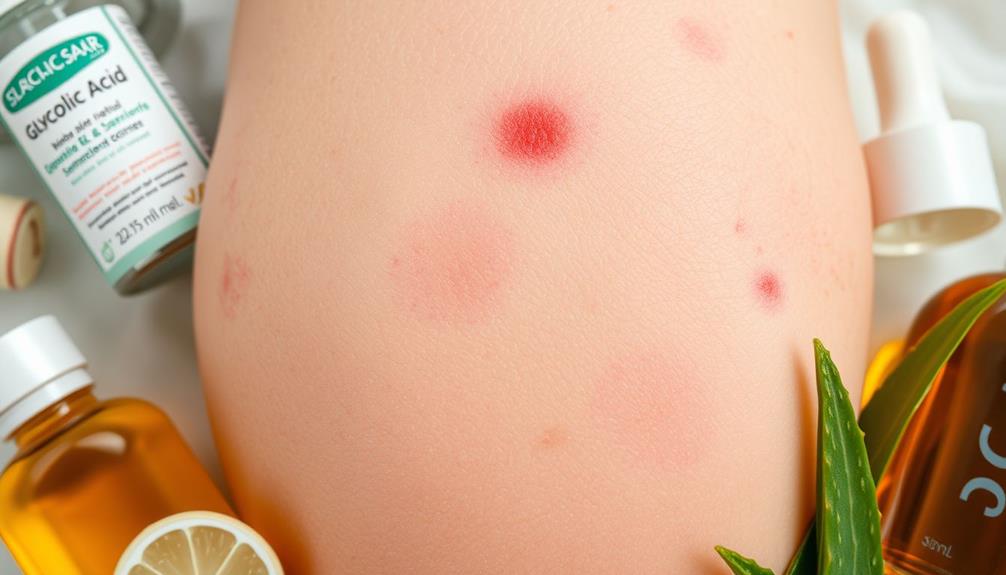
Glycolic acid can lighten dark patches and improve skin texture, but it won't completely eliminate scars. While it's effective in softening the appearance of raised and pitted scars, understanding its limitations is essential for scar treatment.
Here are key points to take into account:
- Professional glycolic acid peels can provide more significant results than over-the-counter products, especially at higher concentrations.
- The effectiveness of glycolic acid varies based on individual skin types and the specific nature of your scars.
- For best results, think about combination therapies; pairing glycolic acid with treatments like microneedling can enhance outcomes, especially for acne scars.
- Alternative treatments, such as laser therapy or fillers, may be more suitable for deeper scars since glycolic acid alone mightn't suffice.
Product Availability
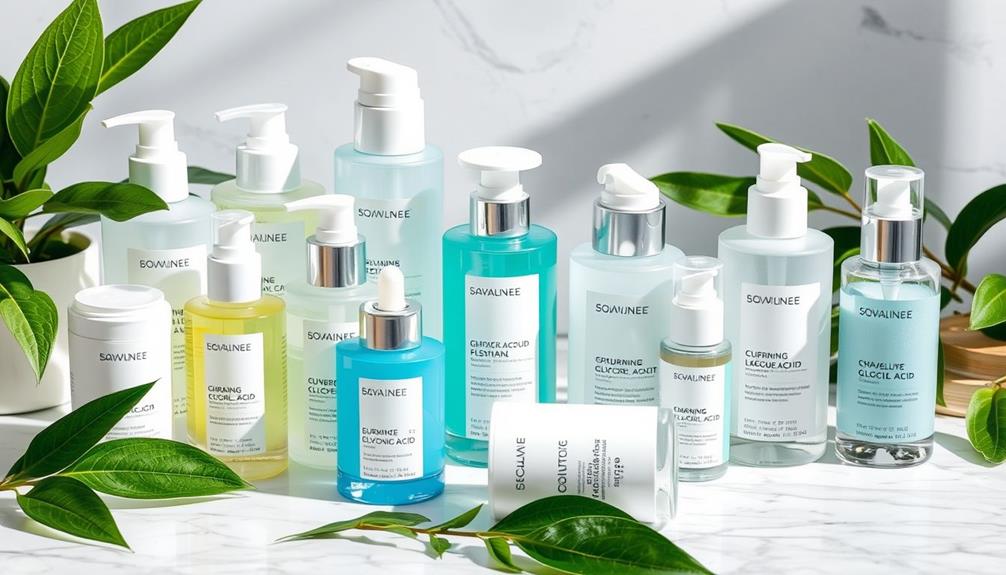
Many skincare brands offer a variety of glycolic acid products, making it easy for you to incorporate this ingredient into your routine.
You can find glycolic acid in over-the-counter (OTC) products like cleansers, toners, serums, and moisturizers, typically with concentrations up to 10%. These formulations are designed for ideal skin tolerance and effectiveness, usually having a pH around 4.
If you're looking for something stronger, professional-grade glycolic acid peels are available in salons and dermatology offices. Salons might offer light-duty peels with concentrations up to 30%, while dermatologists can provide treatments with strengths reaching 70%.
When shopping, make sure to check that glycolic acid is listed as a key ingredient in the products you're considering. This guarantees you're using a formulation that truly benefits your skin.
Keep in mind that DIY sugar scrubs won't give you the same results; they lack the concentrated formulation necessary for effective exfoliation.
With so many products containing glycolic acid, you're sure to find one that fits your skincare needs and helps achieve your desired results.
Safety and Side Effects

Using glycolic acid can offer significant benefits for your skin, but it's important to be aware of the potential safety concerns and side effects associated with this powerful exfoliant.
While many people enjoy its effects, you should take precautions to minimize risks, especially if you have sensitive skin.
Here are some key points to reflect on:
- Glycolic acid can cause skin irritation, such as redness, burning, or peeling, particularly in higher concentrations.
- Increased sun sensitivity is common, making daily sunscreen application essential to prevent sunburn.
- Concentrations of 10% or lower are generally safe for over-the-counter use, but higher concentrations require dermatologist supervision.
- Patch testing is vital before applying glycolic acid widely, as it helps identify any potential allergic reactions.
Choosing the Right Products

Selecting the right glycolic acid products can greatly enhance your skincare routine while minimizing potential irritation. Start by looking for glycolic acid products with concentrations between 5% to 10% for at-home use, as they're effective yet safe for most skin types.
Aim for products with a pH level around 4, which aligns with your skin's natural acidity, improving glycolic acid's efficacy. It's wise to begin with a single product to monitor skin reactions before adding more to your regimen.
Consider formulations like serums or creams, as they often provide better leave-on benefits compared to wash-off products. Always read product labels to understand usage instructions, and be mindful of the recommended application frequency to avoid over-exfoliation.
Here's a simple guide to help you choose:
| Product Type | Recommended Concentration | pH Level |
|---|---|---|
| Serums | 5% – 10% | ~4 |
| Creams | 5% – 10% | ~4 |
| Wash-off | <5% | >4 |
Research and Clinical Insights
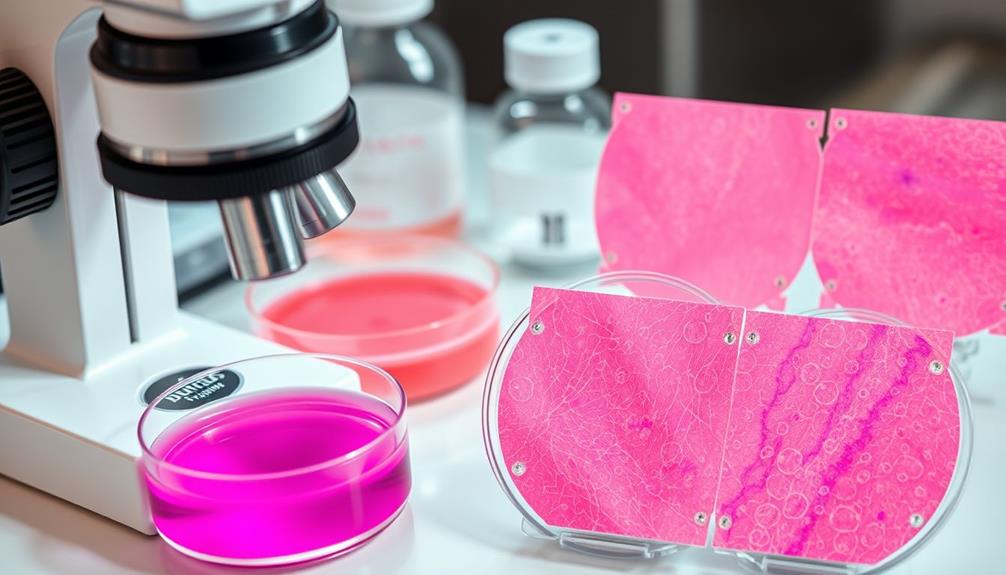
Research has shown that glycolic acid not only enhances your skincare routine but also delivers significant benefits for various skin concerns, backed by clinical evidence.
As an alpha hydroxy acid, glycolic acid boasts powerful exfoliating properties that can transform your skin. Here are some key insights from recent studies:
- Improves skin elasticity, tone, and hydration, effectively reversing visible signs of photoaging.
- Reduces the appearance of acne scars and skin discolorations, including those caused by sun damage.
- Boosts collagen production, helping to diminish fine lines and wrinkles.
- Clinical trials indicate significant improvements in mild to moderate acne vulgaris with just 5% concentrations.
Incorporating glycolic acid into your regimen can make a noticeable difference. Its ability to exfoliate, promote collagen production, and address skin concerns like acne scars and discolorations makes it a powerful addition.
Whether you're dealing with photoaging or seeking clearer skin, the evidence supports its effectiveness in achieving your skincare goals.
Frequently Asked Questions
What Is the Problem With Glycolic Acid?
Glycolic acid can cause skin irritation, increase sensitivity to sunlight, and worsen existing conditions if overused. You should consult a dermatologist before incorporating it into your routine, especially if you have sensitive skin or existing issues.
What Does Glycolic Acid Do to Your Skin?
Ever wondered how to achieve brighter skin? Glycolic acid exfoliates dead cells, boosts collagen, and unclogs pores. It can help fade dark spots, reduce fine lines, and improve your skin's overall texture with regular use.
What Are the Bad Side Effects of Glycolic Acid?
Glycolic acid can cause irritation, redness, and burning, especially if you have sensitive skin. You might also experience dryness or allergic reactions. Always patch-test and consult a professional if you notice severe side effects.
Does Glycolic Acid Cause Skin Thinning?
While some worry glycolic acid causes skin thinning, it actually promotes cell turnover and collagen production. If you use it properly, you'll likely notice healthier, thicker skin rather than any long-term thinning.
Conclusion
Incorporating glycolic acid into your skincare routine can be a game-changer for achieving that radiant glow, much like polishing a vintage car to disclose its hidden brilliance.
By understanding its benefits and using it safely, you're well on your way to healthier skin.
Remember to choose the right products and consult a professional if you have concerns.
With the right approach, glycolic acid can help you reveal your skin's true potential, making you feel confident and refreshed.

